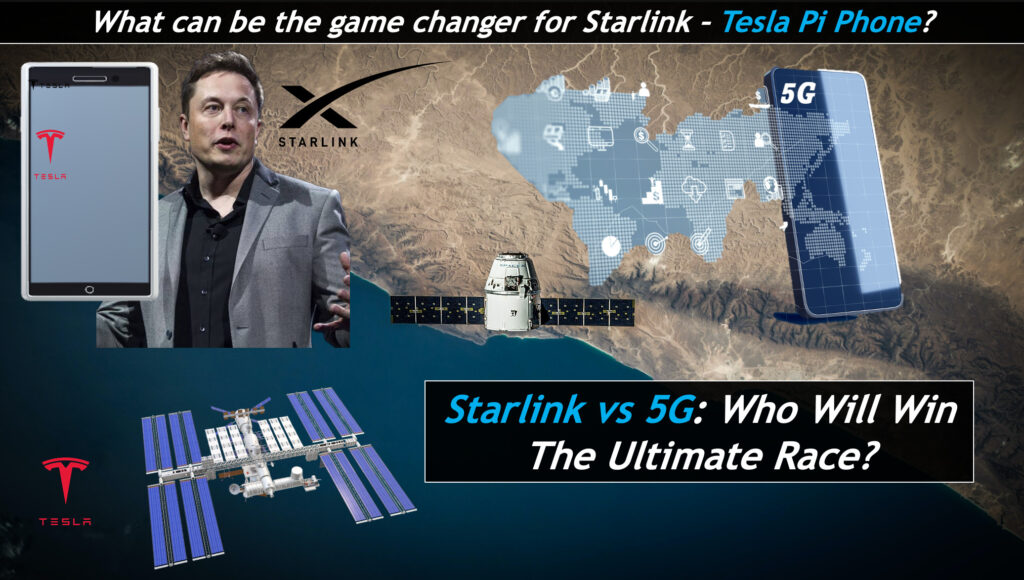“STARLINK vs 5G – Who Will Win The Ultimate Race?” is a hot topic that the world is interested in and I did some research on it therefore. So, I thought I would share my findings with everyone.
Starlink is created by SpaceX to provide fast internet by using Satellites. The session explains why we need Starlink and how Starlink solves the slow VSAT data issue. It also shows actual data comparing download/upload speeds of Starlink and Mobile 5G. Then, we take a look at various challenges that Starlink might face in their race with 5G and other data carriers along with potential solutions.
Lastly, we consider the introduction of Tesla Pi Phone and discuss how it can be the game changer and revolutionize the space.
STARLINK vs 5G – Who Will Win The Ultimate Race? Will Tesla Pi Phone Be A Game Changer For Elon Musk?
0:00 Start
0:46 Why Do We Need STARLINK?
5:15 How Fast Is STARLINK?
9:20 IDEA: How To Reduce Latency in STARLINK?
10:06 Major STARLINK Challenges
13:10 IDEA: Coordinated Handover?
14:56 IDEA: Lower Frequency Range
15:24 Who Is The Winner?
17:32 Tesla Pi Phone – Game Changer?
20:02 Potential Solutions for Mobile & STARLINK Connectivity
How Starlink Works?
Using S=v*t, we can see that 35786km require around 120ms for electromagnetic waves to travel. This means that a ping latency would be around 120*4 = 480ms + the processing overhead of each device which will easily make it above 500ms.
On the other hand, Starlink satellites are on 550km away from the earth with a one way trip time of only 2ms and a total ping RTT would be around 2*4=8ms. Adding any other processing overheads, this should have a RTT of somewhere between 20 to 30ms.
How Fast is Starlink?
Starlink has shared a massive increase in number of users over 2022. Globally, Starlink had around 150k users in the beginning of 2022. However, they have announced that currently, they have more than a million users. The increase in users seem to have brought the speeds down.
However satellite counts are increasing too with more than 3000 already in orbit and a future plan to have around 12000 Starlink satellites in orbit.
Adding CDN capabilities in some of the satellites might bring down latency significantly.
Starlink Challenges
The first big challenge would be that Starlink needs a big antenna to maintain the connection.
This means that if anyone wants a Starlink connection, they need to install an antenna and then connect to a Router via cable and that router provides WiFi to the house. This solution is easy for home broadband but cannot win against mobile 5G which has a much higher user penetration and numbers.
Secondly, the satellites are not geo-stationary and as such they keep moving and the serving satellite will keep changing.
This means that whenever a serving satellite goes out of sight, the receiver antenna will need to recalibrate and find another satellite to get the connection. Although this process is pretty fast but it can still create latency and jitter and buffering of data.
Lastly, the satellite links used C-Band which are high frequency bands and usually require LOS (Line Of Sight) clearance. So, if there is clutter like tall buildings, it will make it difficult for Starlink users to get good service.
Pro Tip – Consider using lower frequency for better penetration and coverage.
Who is the Winner?
In Rural and Sub-Urban Areas or Areas where telecom coverage is not present, Starlink is a clear winner as it can get a connection everywhere or anywhere
In Cities and Urban Areas, Mobile 5G is a better use case due to more penetration of users, better indoor coverage and better mobility. Thanks to this coverage, it’s why eSIM for travel options are so popular for globe-trotters and those who move around different areas often.
From Service perspective, broadband services like streaming and normal browsing services, both 5G Mobile and Starlink are good. But services which require strict latency concerns, Mobile 5G might be better as Starlink will have latency variations.
Will Tesla Pi Phone be the Game Changer?
However, Tesla’s Pi Phone can change everything.
Right now Apple and Samsung phones mostly dominate the handset world but if Tesla’s Pi Phone comes with the ability to support normal 4G/5G plus a native connection to Starlink then that has the potential to upset the global handset market and open up many new Use Cases!
Why would anyone not buy a Tesla Pi Phone if it can connect anywhere you go. You go for vacations to any country and get a connection to Starlink via your Tesla Pi Phone.
Moreover, the Starlink can provide Roaming Services to telecom providers where the telecom providers cannot reach easily. Starlink can even provide Remote Backhaul for telecom sites.
Challenges
– Upload from Mobile to Satellite will be a big bottleneck due to smaller transmit power and antenna gain.
– Multiplexing techniques might need to change based on mobile requirements
Ideas
– Use Lower Frequency
– High Gain Antennas at Satellites with Rx Beamforming
– Multiple Point Reception at Satellites providing Rx Diversity
The Potential That Starlink Has, Even Sky Is Not The Limit For Them, They Have Gone Beyond That And They Are Not Stopping!
If this has been helpful, then please also subscribe to our Youtube channel – Our Technology Planet for more exciting stuff and videos.
Ali Khalid
Latest posts by Ali Khalid (see all)
- 5G Coverage Expansion Analysis – Find The Optimal 5G Coverage Threshold For Your Network - November 9, 2024
- 5G Coverage Expansion - November 9, 2024
- 5G SA Cell Search & Network Entry Matrix - July 18, 2023
